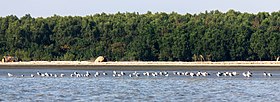Barguna District - Simple English Wikipedia, the free encyclopedia
Barguna বরগুনা | |
|---|---|
| Barguna District | |
| From top: Seabirds in Barguna Coastal area (Laldia beach), Tengragiri Wildlife Sanctuary, Bibicini Shahi Mosque, Haringhata Reserved Forest, Ashar Chor and Bibicini Shahi Mosque | |
 Location of Barguna in Bangladesh | |
 Expandable map of Barguna District | |
| Coordinates: 22°09′03″N 90°07′35″E / 22.1508°N 90.1264°E | |
| Country | |
| Division | Barisal Division |
| Government | |
| • Deputy Commissioner | Mustain Billah |
| • District Council Chairman | Md. Delwar Hossein [1] |
| • Chief Executive Officer | Md. Owahedur Rahman |
| Area | |
| • Total | 1,939.39 km2 (748.80 sq mi) |
| Population (2011 census) | |
| • Total | 892,781 |
| • Density | 460/km2 (1,200/sq mi) |
| Literacy rate | |
| • Total | 62.10% |
| Time zone | UTC+06:00 (BST) |
| HDI (2018) | 0.586[2] medium · 16th of 21 |
Barguna is a district in South-western Bangladesh. It is a part of the Barisal Division. It has a total area of 1831.31 km². It is bordered on the north by the districts of Jhalokati, Barisal, Pirojpur and Patuakhali. In the east, it borders Patuakhali District. On the south, Barguna is bounded by Patuakhali District, the Bay of Bengal. On the western side, it borders Pirojpur and Bagerhat districts. Important rivers of Barguna district include the Payra river, Bishkhali river and the Baleshwar river.
Administration
[change | change source]Barguna is divided into 6 upazilas:
- Amtali Upazila
- Taltali Upazila
- Bamna Upazila
- Barguna Sadar Upazila
- Betagi Upazila
- Patharghata Upazila
There are a total of 38 union parishads (union councils), 238 mouzas and 560 villages in these five upazilas. Barguna also has four municipalities containing 44 wards and 49 mahallas.
The largest city in the district is Barguna Town. It has a total area of 15.57 km² and is divided into 9 wards and 19 mohallas.
People
[change | change source]As of 2007, Barguna District has a population of 902,465, females constitute a majority of the population with a percentage of 50.12% while males constitute 49.88%. 91.01% of the people are Muslim, 8.69% Hindu, 0.04% Christian, 0.24% Buddhist, and 0.02% other.
References
[change | change source]- ↑ zp.barguna.gov.bd
- ↑ "Sub-national HDI - Area Database - Global Data Lab". hdi.globaldatalab.org. Retrieved 2020-03-18.


 French
French Deutsch
Deutsch





